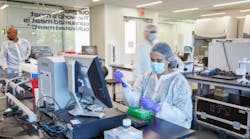Research and development at Eat Just, a manufacturer of plant-based egg and cultivated meat products, is an orchestration that combines science with art.
“We have a number of different departments that feed the innovation chain,” says Peter Licari, chief technology officer of Eat Just. “We have a very deep scientific organization complemented with a very creative culinary team. We put a lot of energy into being a true interdisciplinary team where scientists are working with the culinary experts, as well as engineers and food scientists. It's a very collaborative environment.”
The R&D team’s 80 members are divided among Eat Just’s egg and meat divisions. The disciplines include molecular biologists, chemists, food scientists, process development engineers, culinary experts and others. The group includes seven chefs, several of whom previously worked in Michelin-starred restaurants.
More than three quarters of the team works in the company’s Alameda, Calif., research facility – which opened in April – and the rest in a facility in Singapore. The company also collaborates with third-party organizations; a company in Germany, for example, is currently involved in improving mung bean protein, a key ingredient in Eat Just’s products.
Having teams in different parts of the world helps Eat Just create products that please different palates, Licari says.
“Different geographies have different tastes. Where one geography might like a flavor of our egg, another may not,” he says. “So we try to compensate for that through process or ingredient, and that requires getting smart people around the table. I think having that diversity of geography, of culture and education, is important.”
Equally important is collaboration among the different disciplines involved in a product. Three or four times a week, team members meet in tastings to examine products that are underway, Licari says. When a tweak is made in one aspect of formula or process, team members of all affected disciplines weigh in.
“Let's say we make a subtle adjustment on temperature or pH, that can have very serious consequences to the quality of the product, good or bad,” he explains.
“And so, if we make a change at our Minnesota plant, that material gets shipped here and usually within a day or two, we'll do this interdisciplinary tasting and people see the impact.
“The feedback loop is essential because the texture and flavor of egg is so unique, and very subtle changes can have dramatic impact on the product quality and functionality. We've learned over time that you can’t make a change in a vacuum. We need to be a single unit and we all need to be pushing in the same direction.”
This is the second of our 2022 R&D Teams of the Year profiles. Eat Just won in the medium-sized company category, defeating Bellisio Foods, a worthy competitor. Last month we profiled SunOpta, winner of the large-company category; next month the focus will be on Sophie’s Kitchen in the small category.
We pit teams against each other in those three size categories, putting their essays on a web-based poll this spring and asking our readers to choose the winners. 421 of you voted – thank you very much!
In 2021, the research team began the work needed to transition to version 4 of the Just Egg product, which was first introduced in 2019.
“Last year our effort was to make the product taste and have texture more comparable to an egg,” Licari says. “Initially the first version had a beanie flavor from the mung beans and didn't gel as well. Through a variety of process steps that we've implemented, we've been able to greatly reduce the bean flavor and have a more egg-like texture.”
But the team’s work went beyond improving the actual product. Supply chain problems, which have affected so much of the food industry, received a lot of R&D attention as well, Licari says.
For example, mung beans from different geographies have different tastes – just like coffee made from beans grown in Mexico tastes different from coffee made from African beans. That fact makes it difficult to develop redundancy in the supply chain, since the flavor of the final product cannot vary. Eat Just’s research team tackled that problem by developing a process that homogenizes the flavor of the product regardless of the origin of the beans.
“Most of that work is done in the protein processing part of the plant, but it really required an intense activity in the formulation development as well,” Licari explains. “So, in the end we had greater redundancy on bean supply. Our cost of goods came down and the product is better than V3 was from a taste and texture perspective.”
Like all companies, the pandemic forced Eat Just to make some adjustments, such as relying more on FedEx to deliver samples and Microsoft Teams meetings for collaboration. But ultimately the pandemic did not limit Eat Just’s R&D success.
“We hit our cost targets for last year. We more than tripled our output on the protein side. We developed new final products that hopefully we'll have on the shelf this summer. And we continue on the regulatory charge,” Licari says.
“We had an objective to say, ‘Ignore the pandemic,’ and the group really went about achieving our goals despite different restrictions we had imposed on us.”


